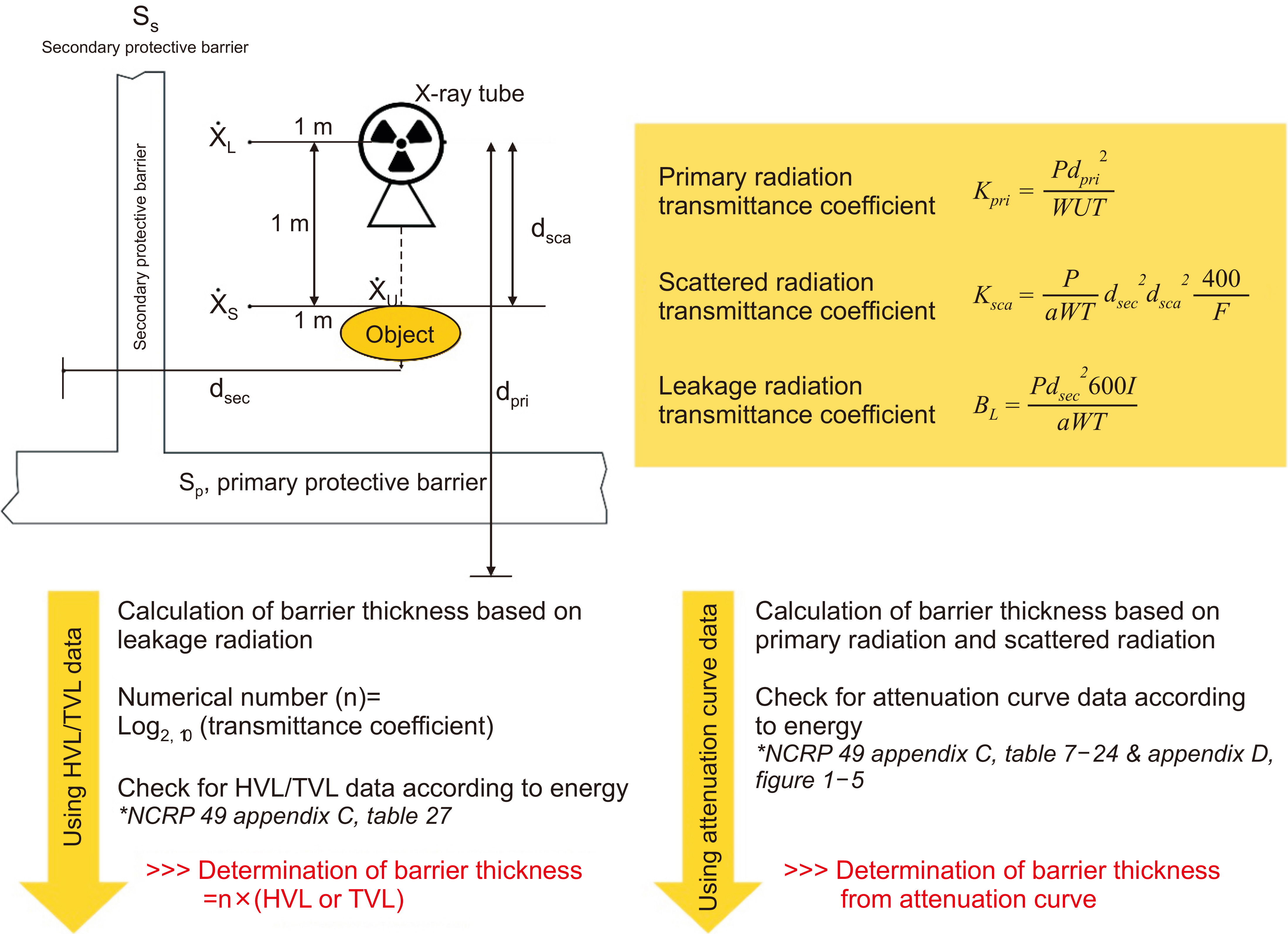Prog Med Phys.
2022 Dec;33(4):53-62. 10.14316/pmp.2022.33.4.53.
Review of Shielding Evaluation Methodology for Facilities Using kV Energy Radiation Generating Devices Based on the NCRP-49 Report
- Affiliations
-
- 1Department of Radiation Oncology, Yonsei Cancer Center, Heavy Ion Therapy Research Institute, Yonsei University College of Medicine, Seoul, Korea
- 2Medical Physics and Biomedical Engineering Lab (MPBEL), Yonsei University College of Medicine, Seoul, Korea
- 3Department of Physics, Yonsei University, Seoul, Korea
- 4Department of Medical Physics, Korea University, Seoul, Korea
- 5Radiation Safety Section, Korea Institute of Radiological and Medical Sciences, Seoul, Korea
- 6Research Team of Radiological Physics & Engineering, Korea Institute of Radiological & Medical Sciences, Seoul, Korea
- 7Department of Radiation Oncology, Korea Institute of Radiological & Medical Sciences, Seoul, Korea
- 8Oncosoft Inc., Seoul, Korea
- KMID: 2537872
- DOI: http://doi.org/10.14316/pmp.2022.33.4.53
Abstract
- In this study, we have investigated the shielding evaluation methodology for facilities using kV energy generators. We have collected and analysis of safety evaluation criteria and methodology for overseas facilities using radiation generators. And we investigated the current status of shielding evaluation of domestic industrial radiation generators. According to the statistical data from the Radiation Safety Information System, as of 2022, a total of 7,679 organizations are using radiation generating devices. Among them, 6,299 facilities use these devices for industrial purposes, which accounts for a considerable portion of radiation. The organizations that use these devices evaluate whether the exposure dose for workers and frequent visitors is suitable as per the limit regulated by the Nuclear Safety Act. Moreover, during this process, the safety shields are evaluated at the facilities that use the radiation generating devices. However, the facilities that use radiating devices having energy less than or equal to 6 MV for industrial purposes are still mostly evaluated and analyzed according to the National Council on Radiation Protection and Measurements 49 (NCRP 49) report published in 1976. We have investigated the technical standards of safety management, including the maximum permissible dose and parameters assessment criteria for facilities using radiation generating devices, based on the NCRP 49 and the American National Standards Institute/Health Physics Society N.43.3 reports, which are the representative reports related to radiation shielding management cases overseas.
Figure
Reference
-
References
1. Radiation Safety Management Integrated Information Network. 2022 . Industry/regional licensing information on radioisotopes (RI). Radiation Safety Management Integrated Information Network, 2022;Daejeon: Available from: https://rasis.kins.re.kr/. cited 2022 Nov 29.2. Nuclear Safety and Security Commission. 2019. Nuclear Safety Commission Notice No. Nuclear Safety and Security Commission, 2019;Seoul: Available from: https://www.law.go.kr/%ED%96%89%EC%A0%95%EA%B7%9C%EC%B9%99/%EB%B0%A9%EC%82%AC%EC%84%A0%EB%B0%A9%ED%98%B8%EB%93%B1%EC%97%90%EA%B4%80%ED%95%9C%EA%B8%B0%EC%A4%80/. cited 2022 Nov 29.3. Nuclear Safety and Security Commission. 2021. Presidential Decree No. Nuclear Safety and Security Commission, 2021;Seoul: Available from: https://www.law.go.kr/%EB%B2%95%EB%A0%B9/%EC%9B%90%EC%9E%90%EB%A0%A5%EC%95%88%EC%A0%84%EB%B2%95%EC%8B%9C%ED%96%89%EB%A0%B9. cited 2022 Nov 29.4. Nuclear Safety and Security Commission. 2021. Nuclear Safety Commission Notice No. Nuclear Safety and Security Commission, 2021;Seoul: Available from: https://www.law.go.kr/%ED%96%89%EC%A0%95%EA%B7%9C%EC%B9%99/%EB%B0%A9%EC%82%AC%EC%84%A0%EA%B8%B0%EA%B8%B0%EC%9D%98%EC%84%A4%EA%B3%84%EC%8A%B9%EC%9D%B8%EB%B0%8F%EA%B2%80%EC%82%AC%EC%97%90%EA%B4%80%ED%95%9C%EA%B8%B0%EC%A4%80/. cited 2022 Nov 29.5. Nuclear Safety and Security Commission. 2019. Nuclear Safety Commission Notice No. Nuclear Safety and Security Commission, 2019;Seoul: Available from: https://www.law.go.kr/%ED%96%89%EC%A0%95%EA%B7%9C%EC%B9%99/%EB%B0%A9%EC%82%AC%EC%84%A0%EC%95%88%EC%A0%84%EB%B3%B4%EA%B3%A0%EC%84%9C%EC%9E%91%EC%84%B1%EC%A7%80%EC%B9%A8/. cited 2022 Nov 29.6. National Council on Radiation Protection and Measurements (NCRP). 1976. Structural shielding design and evaluation for medical use of X rays and gamma rays of energies up to 10 MeV. NCRP;Bethesda: p. 49.7. American National Standards Institute (ANSI). 2008; ANSI/HPS N43.3. Installations using non-medical X-ray and sealed gamma-ray sources, energies up to 10 MeV. ANSI. DOI: 10.1007/978-0-387-73003-5_512.8. National Council on Radiation Protection and Measurements (NCRP). 2006. Structural shielding design and evaluation for megavoltage x-and gamma-ray radiotherapy facilities. NCRP;Bethesda: p. 151.9. Kelley JP, Trout ED. 1972; Braod-beam attenuation in lead for x rays from 50 to 300 kVp. Radiology. 104:171–175. DOI: 10.1148/104.1.171. PMID: 5033581.
Article10. Miller W, Kennedy RJ. 1955; X-ray attenuation in lead, aluminum, and concrete in the range 275 to 525 kilovolts. Radiology. 65:920–925. DOI: 10.1148/65.6.920. PMID: 13273659.
Article
- Full Text Links
- Actions
-
Cited
- CITED
-
- Close
- Share
- Similar articles
-
- Survey of Safety Regulation and Evaluation of the Shielding Facility for the Medical Linear Accelerator
- Survey of Radiation Shielding Design Goals and Workload Based on Radiation Safety Report: Tomotherapy Vault
- Status of Domestic and International Recommendations for Protection Design and Evaluation of Medical Linear Accelerator Facilities
- Dose distribution of high energy electron by shielding material
- 50–300 kVp X-ray Transmission Ratios for Lead, Steel and Concrete



